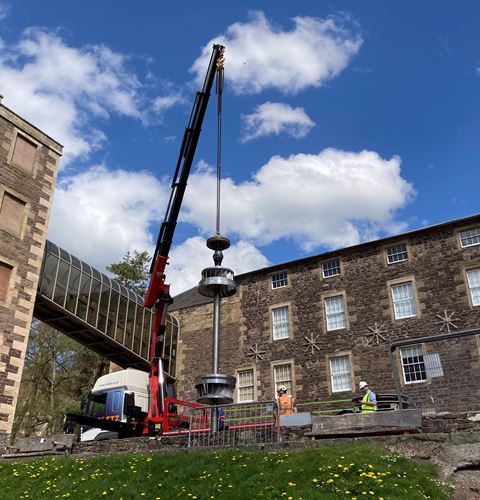New Lanark Mills Refurbishment
Glasgow, Scotland
New Lanark Mills History
In 2020 Gilkes was awarded a contract to refurbish a 1931 Boving twin runner Francis turbine at New Lanark Mills. New Lanark Mills is a world heritage site around 20 miles southeast of Glasgow. Founded in 1785 with a focus on philanthropy, education and the welfare of the mill workers, New Lanark became a model for industrial communities that was to spread across the world in the 19th and 20th centuries.
Original Equipment
Gilkes arrived on site during January 2021 to dismantle the turbine, discovering the guide vane mechanism had so much wear, that a guide vane had come into contact with a runner, damaging the runner and guide vanes beyond repair. A lot of internal components had corroded and seized. This meant that the turbine would require additional components including new guide vanes, guide vane mechanism, turbine shaft, runners, and refurbished chambers. Following the initial site assessment, Gilkes returned to site in October 2021 to remove the remaining failed components including the 5.5m shaft and runner assembly in one piece. Only the empty shell of the case was left on site.
Reverse Engineering
Despite the equipment being in an advanced state of decay it was possible to scan enough of one runner to recreate the full hydraulic geometry. The resulting 3D CAD model was used to validate the hydraulic and structural performance of the design before CNC milling replacement runners. Two mirror imaged runners where machined from solid stainless-steel billets. The same process was complete for the guide vanes.
Gilkes reverse engineering capability is centred on its 3D scanning technology. A Creaform handheld laser scanner allows access to complex turbine geometry capturing detail up to 25µm resolution. Surfacing software is then used to automatically thin the dense scan data and fit the cleanest possible CAD surfaces through the scanned points. The 3D CAD model then becomes the basis for manufacture of new components that fit seamlessly with existing machinery.
Key Stats
- Original Installation 1931
- Modernisation 2022
- Power 400kW
- Net Head 9.75m
- Flow 5000l/s
- Turbine Boving Twin Runner Francis
Installation
In April 2022 Gilkes site team were able to install the refurbished components.
The turbine is installed in the basement of mill number 3. When the turbine was modified to power a generator, a new access hatch approximately 4m2 was built on the side of the mill to provide access to the turbine hall. This proved problematic for removal and delivery of turbine parts, in particular the shaft assembly, complete with pre-installed runners. Due to the assembly length, it required a complex two position lift utilising both the turbine hall crane and a lorry mounted crane.
All parts where successfully lowered in without a scratch, the order being critical as space below was limited. The chambers were delivered to site with guide vanes and links fully assembled, having been tested in the workshop to reduce assembly time on site. The refurbished Hydraulic Power Unit was fitted, and operation of the guide vane mechanism was tested. This mechanism had been redesigned to include self-lubricating bushes and corrosion resistant materials, reducing maintenance and prevent the initial failure reoccurring. The new mechanism worked very well and allowed for smooth operation throughout the positions. After the completion of the turbine, the refurbished gearbox and generator were lifted into position and aligned using a digital alignment tool.
Installation went surprisingly smoothly for a machine of this age, allowing commissioning work to begin. The turbine was slowly started up, gradually generating more power. The turbine is fed by a lade which brings in water from the river Clyde. Since the initial work began over two years earlier, the lade had been isolated, allowing a build-up of vegetation. Some of the vegetation was cleared by running water through the lade and out via a diversion, however significant amounts were still present. Following start-up of the turbine, the turbine debris screen kept blocking, hampering running. Eventually most of this debris cleared allowing successful running.
Installation took two working weeks, followed by a further two weeks of electrical and commissioning. Output of the machine has been measured to be around 400kW.
New Lanark World Heritage Site
Today New Lanark UNESCO World Heritage Site is a unique 18th century Mill Village sitting alongside the picturesque River Clyde, less than one hour from Glasgow and Edinburgh. The ongoing conservation and promotion of this unique village and the award-winning visitor attraction is managed by New Lanark Trust, in partnership with South Lanarkshire Council & Historic Environment Scotland.

